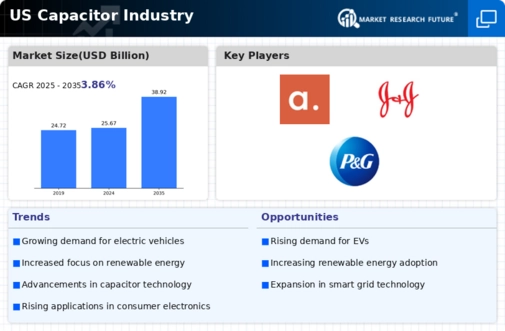Expansion of Electric Vehicle Infrastructure
The capacitor market is significantly influenced by the rapid expansion of electric vehicle (EV) infrastructure in the United States. As the automotive industry shifts towards electrification, the demand for capacitors in EVs is expected to rise substantially. Capacitors are essential components in electric drivetrains, contributing to energy efficiency and performance. The U.S. government has committed to investing over $7 billion in EV charging infrastructure, which is anticipated to create a favorable environment for capacitor manufacturers. This investment is likely to stimulate innovation in capacitor technology, leading to the development of high-performance capacitors that meet the evolving needs of the automotive sector. Consequently, the capacitor market stands to benefit from this burgeoning trend.
Rising Demand for Renewable Energy Solutions
The capacitor market is experiencing a notable surge in demand due to the increasing adoption of renewable energy solutions across the United States. As the nation transitions towards sustainable energy sources, capacitors play a crucial role in energy storage systems, particularly in solar and wind energy applications. The integration of capacitors in these systems enhances efficiency and reliability, thereby driving market growth. According to recent data, the renewable energy sector is projected to grow at a CAGR of approximately 10% over the next five years, which is likely to positively impact the capacitor market. This trend indicates a robust opportunity for manufacturers to innovate and develop capacitors tailored for renewable energy applications, further solidifying their position in the market.
Growth in Telecommunications and Data Centers
The capacitor market is benefiting from the growth in telecommunications and data centers, which are critical components of the digital economy. As the demand for high-speed internet and data processing capabilities increases, the need for reliable power supply systems becomes paramount. Capacitors are integral to power management solutions in these facilities, ensuring stability and efficiency. The telecommunications sector is expected to grow at a CAGR of 8% through 2027, driven by the expansion of 5G networks and cloud computing services. This growth is likely to create a robust demand for capacitors that can support the evolving needs of the telecommunications infrastructure. Consequently, the capacitor market is positioned to capitalize on this trend, as manufacturers develop products tailored to the specific requirements of this sector.
Increased Focus on Energy Efficiency Regulations
The capacitor market is being shaped by the heightened focus on energy efficiency regulations in the United States. Government initiatives aimed at reducing energy consumption and promoting sustainable practices are driving the demand for energy-efficient capacitors. The implementation of stricter energy standards across various industries, including manufacturing and construction, is likely to propel the adoption of capacitors that meet these regulations. For instance, the U.S. Department of Energy has set ambitious targets for energy efficiency improvements, which could lead to a market shift towards capacitors that offer superior performance. This regulatory environment presents an opportunity for capacitor manufacturers to innovate and align their products with energy efficiency goals, thereby enhancing their market presence.
Technological Innovations in Consumer Electronics
The capacitor market is poised for growth driven by technological innovations in consumer electronics. As devices become more compact and energy-efficient, the demand for advanced capacitors that can support high-frequency applications is increasing. The consumer electronics sector, which includes smartphones, tablets, and wearables, is projected to reach a market value of $1 trillion by 2026. This growth is likely to create a substantial demand for capacitors that can enhance device performance and longevity. Manufacturers are focusing on developing capacitors with improved energy density and miniaturization capabilities, which could lead to a competitive edge in the capacitor market. The ongoing advancements in this sector suggest a promising outlook for capacitor manufacturers.













Leave a Comment